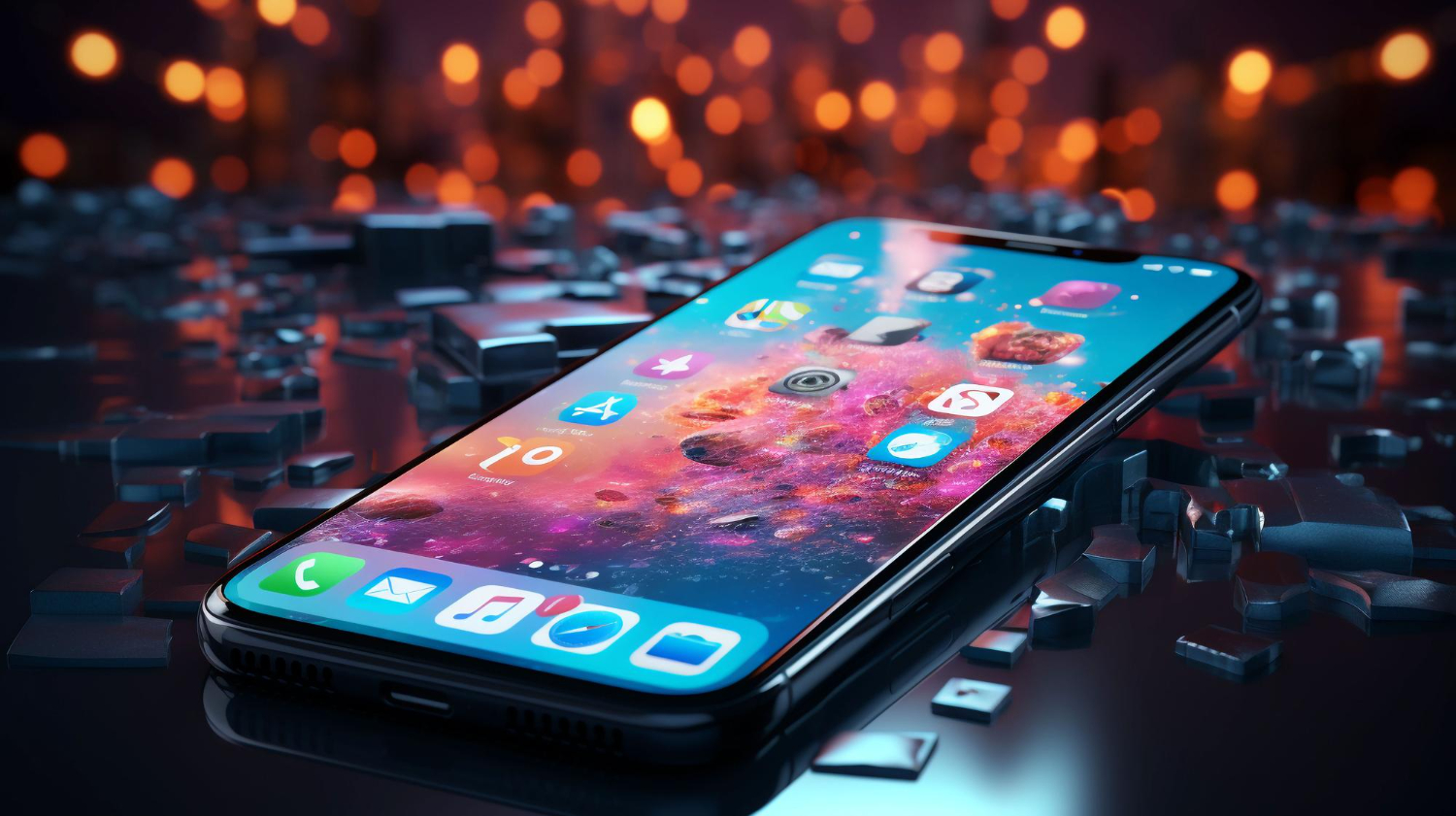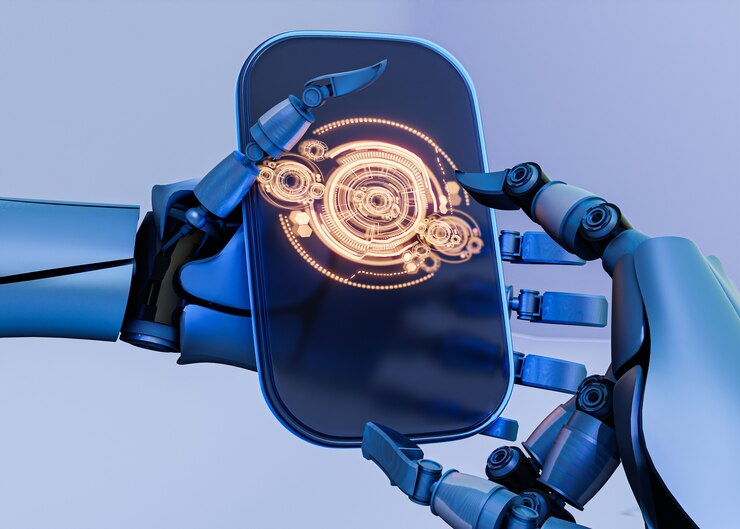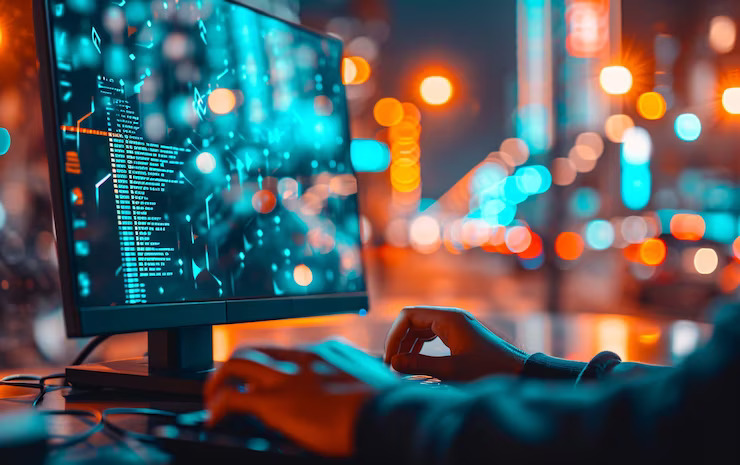BLOG
Mobile App Design Trends: User Experience and Interface Innovations
Do you know that a staggering 5.679 million apps compete for user attention globally?

Achieving success here needs more than a brilliant idea; it requires apps that distinguish themselves with an exceptional user interface (UI) design. This is why adhering to mobile app design guidelines is paramount.
In this article, we explore the UI/UX design trends for 2023, empowering businesses to remain at the forefront of innovation and provide unparalleled user experiences.
The Importance of App Design
Imagine entering a digital world where your initial interaction sets the tone for your entire journey. That’s the magic of a well-crafted user interface (UI). It serves as the visual gateway to the essence of your app and the driving force behind user engagement. But what precisely encompasses UI design?
UI design encompasses the graphical interface that addresses application appearance, user experience, and interactivity. It includes all facets of an interface, from the arrangement of buttons and icons, images and animations, color palettes, and typography to every element a user might engage with.
A superior UI design is more than just eye candy; it forms the framework supporting seamless navigation, user friendliness, and overall functionality. It is why we embrace a design-centric approach to mobile development.
The recent trends in mobile app UI design in 2023:
1. Augmented and Virtual Reality
Reports suggest that by 2024, an astounding 1.73 billion mobile users will embrace augmented reality (AR) without additional equipment like glasses. It makes smartphones the ideal platform for delivering astonishing AR effects.

AR allows users to interact seamlessly with digital content integrated into the physical world. A notable example is the 3D product model view, which enables a users to examine products in digital format before purchase. An excellent example of this is Gucci’s offering of realistic try-on experiences for running shoes.
2. Artificial Intelligence
AI has become a game-changer in mobile app design, revolutionizing everything from customer service chatbots to personalized product recommendations. This technology is at the heart of creating customized experiences and fostering deeper user connections. In 2022, the AI market soared to $80 billion, with projections of reaching $282 billion by 2027.
With AI, mobile app designers can craft adaptable interfaces that cater to individual user preferences. This level of personalization boosts user engagement and simplifies navigation, making each interaction uniquely tailored and effortlessly intuitive. As AI continues to evolve, its integration with mobile app UI design is expanding, offering designers exciting opportunities to innovate and provide increasingly immersive and intelligent experiences.
3. Passwordless Login
In our modern digital age, the struggle of remembering a multitude of passwords for different apps has become a significant challenge. It is no wonder that passwordless login has emerged as a highly desirable feature in mobile app UI design. This trend gained substantial momentum in 2022 and will remain relevant throughout 2023.
Many apps have adopted alternative authentication methods such as Face ID, Touch ID, one-time temporary passwords, sign-in links, and social media integration. These technologies streamline the login process and enhance security, striking a perfect balance between convenience and safety.
4. Voice User Interface and Touchless Interaction
In the ever-evolving landscape of mobile UX trends in 2023, voice interaction and contactless functionality are taking center stage, with virtual assistants like Google Assistant, Siri, and Alexa leading the way. Voice-enabled apps offer quick and accurate responses to user queries, creating a seamless and personalized experience beyond traditional touch-based interactions. Embrace the fusion of sound and technology to design an app experience that genuinely resonates with your users.
5. Multi-directional Navigation
A fresh navigation approach has surfaced in app UI design, offering an innovative solution to simplify complex user flows and interactions. This method incorporates horizontal sliders within vertically scrolling interfaces, encouraging dynamic engagement.
Multi-directional navigation adds visual appeal and enhances usability, making it easier for users to access different sections within the app.
The fusion of these navigation components breaks free from traditional scrolling, fostering a sense of exploration and discovery. As a result, users are more likely to stay engaged, leading to increased satisfaction and improved retention rates.
6. Animation
Animation remains at the forefront of prominent mobile app design trends. It breathes life into static typography, imbues playfulness into sidebars, or enhances navigation, resulting in a more delightful user experience. In 2023, the spotlight will be on 3D animation in mobile app UI design. Incorporating it can yield immersive visuals that can make a difference.
7. Dark mode
Dark mode, characterized by its utilization of darker colors and low-contrast text in interface design, is expected to be a prominent trend in 2023. This design approach offers several advantages for users and designers, contributing to its growing popularity in interface design.
Dark mode, primarily known for its capacity to reduce eye strain and fatigue and it presents a more comfortable visual experience than traditional interfaces featuring bright white backgrounds and high-contrast text. This feature proves especially valuable for individuals who spend extended hours in front of screens, including professionals such as software developers and data analysts.
8. Liquid Swipe and Buttonless Design
The gradual disappearance of physical buttons from devices marks a new design frontier. This transition empowers product designers to present a wealth of information and data to users, prioritizing gesture-driven interactions over traditional digital buttons.
Additionally, techniques like “liquid swipe” promise to elevate gesture effects, delivering a seamless and immersive user experience. Experts from mobile app design companies can assist you in seamlessly integrating liquid swipe functionality and crafting app designs that align with the aesthetics of buttonless devices.
9. Personalization
Personalization is the central trend in app design, as users increasingly anticipate applications offering customized experiences that cater to their requirements. You can achieve this level of personalization by utilizing data analysis, machine learning, and artificial intelligence. In 2023, designers should prioritize the development of apps that deliver uniquely personalized experiences for each user, drawing insights from their preferences and behaviors.
How to Incorporate Mobile App UI/UX Trends into Your Application
Incorporating contemporary design trends into your app can significantly enhance its appeal and user experience. Here are several key strategies to seamlessly integrate these trends into your application:
Embrace Vivid and Striking Colors: In mobile app design, use vibrant colors for attention, and align them with your brand and audience preferences.
Leveraging Captivating Typography: In app design, prioritize captivating typography for personality but maintain legibility and readability for user friendliness.
Adopting Minimalist Layout: Minimalism in mobile app design simplifies layouts with fewer elements, decluttering the interface for user-friendly navigation and easy content access.
Integrating Storytelling Elements: In mobile app design, embrace storytelling. Craft narratives and create immersive experiences to enhance engagement and leave a lasting impression.
Benefits of Using Current UI/UX Design Trends
Design trends in the mobile app industry are constantly changing and evolving. Staying up-to-date with the latest trends can be a challenge, but it’s essential to keep your app’s UI/UX design current to stay ahead of the competition.
There are many advantages to incorporating UI/UX design trends into your mobile app, including:
Keeping Your App Fresh: Aligning your app’s UI/UX with trends shows it’s evolving and modern, fostering user loyalty and discouraging switching to competitors.
Maintaining a Competitive Edge: Embrace UI/UX trends for a competitive edge. Outdated competitor apps may drive users to migrate to yours.
Boosting User Engagement: UI/UX trends can enhance user engagement. A captivating, user-friendly interface can keep users engaged, leading to higher sales and conversions.
Enhancing User Experience: Contemporary UI/UX trends boost user experience, driving satisfaction and loyalty essential for business success.
Successful Examples
Twitter’s Dark Mode: Twitter serves as a prime illustration of an application that has adeptly integrated dark mode. It offers striking contrast and reduces eye strain in low light. It is also battery-friendly and perfect for prolonged mobile use.
Airbnb’s Animated Micro-Interactions: Airbnb uses animated micro-interactions for enhanced user engagement, including button animations, loading indicators, and feedback animations.
Google Maps Voice-based Interfaces: Google Maps excels at voice-based interfaces, allowing users to interact effortlessly with voice commands for convenience and navigation ease.
Netflix Personalization: Netflix demonstrates the power of personalization through data analysis, machine learning, and artificial intelligence. The platform tailors the user experience to individual preferences, presenting a customized homepage with content that aligns with user interests.
Apple Music Minimalism: Apple Music’s minimalist design prioritizes core features and functionality, delivering a simple and intuitive user experience. This approach reduces clutter and facilitates easier content discovery.
IKEA Virtual Reality and Augmented Reality: IKEA effectively employs virtual reality and augmented reality technologies to enable users to visualize furniture in their homes. This immersive experience enables customers to preview home designs in their living spaces before buying.
Uber Chatbots: Uber incorporates chatbots seamlessly into its interface, providing users with a convenient way to interact with the app. The chatbot serves various purposes, including customer support, information retrieval, and appointment scheduling.
Instagram Gesture-based Interfaces: Instagram employs gesture-based interfaces for natural and immersive interactions, enhancing navigation and access to hidden features and making the app user-friendly.
Flipkart Progressive Web Apps (PWAs): Flipkart, a prominent Indian e-commerce platform, successfully implements Progressive Web Apps (PWAs). The PWA version offers a consistent and seamless user experience while improving overall usability.
Google Material Design: Google’s Material Design, characterized by bold colors and shadows, creates a realistic and three-dimensional visual style. Often combined with minimalism, it results in eye-catching yet user-friendly interfaces, aligning with contemporary design trends.
By examining these examples, we can gain valuable insights into how modern UI/UX design trends enhance user experiences.
Conclusion-
In 2023, the evolution of UI/UX design trends will continue, driven by technological advancements and shifting user expectations.
By embracing these trends and prioritizing user-centred design principles, businesses can create exceptional digital experiences that stand out in the competitive landscape and meet the needs of their users.
Related Topics
Trending Topics
Want to build Super app for your business?



